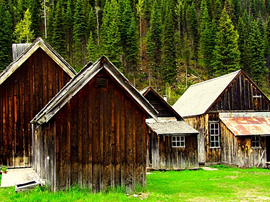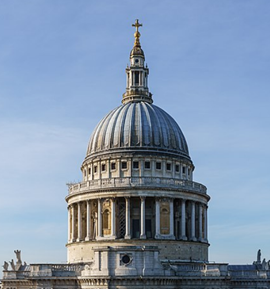Listing Glasgow's Kingston Bridge
Glasgow’s Kingston Bridge, carrying the M8, is listed despite problems with its design, loss of structural authenticity and original fabric, and harmful changes to its appearance.

|
| An upstream view of Kingston Bridge in the 1970s (Photo: Scottish Roads Archive). |
Where buildings constructed in the second half of the 20th century are concerned, recognition of their architectural or historic interest has the capacity to stir strong emotions. It is architecture constructed within some of our lifetimes and experience, architecture we may remember being constructed along with attendant politics, architecture some may even have contributed to. It is, however, architecture we need to carefully consider for statutory protection when the passage of time allows adequate objectivity.
A legacy of the 1945 Bruce Plan, a post-war vision that would have seen the demolition of most of Victorian Glasgow city centre, the 1960s M8 motorway was a design for an era where road building was typically seen as a solution out of congestion and towards economic development. Officially opened in June 1970, the Kingston Bridge’s large single span reads as a pragmatic and economical continuation of the M8 over the River Clyde. Designed by consulting engineers WA Fairhurst and Partners from 1963–67, it is reminiscent of the 1963 M2 Medway Bridge, but more complex. Its cantilevered concrete box girder spans are wider and longer than those of the Medway Bridge, and are delivered with decorative cladding and a dash of style commensurate with its urban environment.
Serious structural issues at the Kingston Bridge emerged as early as the late 1980s, leading to precautionary lane closures, temporary works, monitoring and remedial structural redesign. With the fabric failure and level of intervention required so soon after the bridge opened, my interest was piqued when a proposal emerged to list the bridge as being of ‘architectural or historic interest’ in 2020, in its 50th anniversary year.
Rotation in the north pier foundations cracked the riverside quay wall. Elements of cladding dropped from the bridge into the roadway. The bridge deck dropped 300mm mid-span. Some bridge deck expansion joints were fully locked up, while others were fully open and they were not adjusting with the seasons. One of the bridge piers was leaning. Left without intervention, these extremely serious engineering issues could have been catastrophic, under the right loading circumstances.[1]
Legal action was raised by the roads authority against the consulting engineers in 1992 arguing negligent failures in the design of the bridge.
The Strathclyde Regional Council v WA Fairhurst and Partners judgement by Lord Abernethy in 1996 established that, despite the passage of time, there remained a case for the designer to answer, and ruled that part of the regional council’s case that the bridge was subject to flexural tensile stress contained sufficient averments of a departure from normal and proper practice to go to proof.[2] Reportedly an out-of-court settlement was reached.[3]
Extensive remedial work significantly impacted the bridge’s structural design. It comprised a re-engineering and associated replacement of the bridge’s principal supporting structure, its piers and bearings. During 1991 the banks of the River Clyde were reinforced to resist further thrust from bridge’s foundations. The main part of the £30 million remedial works was undertaken between 1996 and 2000. Following casting of temporary supports and jacking of the bridge deck, all original bridge piers were entirely removed and replaced with a new pier support system.[4] In the words of a Transport Scotland documentary around the time, ‘fundamentally changing in its method, the bridge’s system of articulation’.[5]
Replacement piers were nearly three times the thickness and extended through the full depth of both bridge decks, prejudicing the design concept of the bridge reading as two visually independent parallel structures. Beams cast about the tops of the first row of supporting columns, north and south of the river, with other anchor points, visible on the underside of the bridge, allowed post tensioning and reinforcing. The beams’ angular form projects beyond and below the slender original columns, interrupting the visual continuity of the structure as the elevated road deck meets the bridge.
Jacking and repositioning of the bridge decks, replacement of piers and reinforcing the structure were undoubtedly necessary and may well have been part of a successful, award-winning engineering solution (it was indeed quite an engineering feat), but the form and finish of the works is far removed from the clean lines, visual lightness and character of the original design, detracting significantly from the bridge’s aesthetic.
Nevertheless, following public consultation the Kingston Bridge was listed at Category C in November 2020 (not Category B as originally proposed). This listing continues to sit uneasily in the panoply of 20th-century bridge listings, of which there are a good many fine examples, including the athletic 1984 Kylesku, airy 1971 Erskine Bridge or elegant 1964 Forth Road Bridge. They are crossing events redolent of their period, brimming with design endeavour.
The Kingston Bridge seems very different. It remains difficult to reconcile its design, subsequent loss of structural authenticity and original fabric and the resultant harmful changes to its appearance with a decision to list in terms of design or architectural interest.[6]
It begs the question, what is design quality and how should that contribute to architectural interest? While key factors, set out in Annex 2 of Historic Environment Scotland’s Designation Policy and Selection Guidance [7] are not intended to be an exhaustive list, nor necessarily a template, it is interesting that reference is made to ‘technological excellence or innovation’ as a contributor to design quality (and is materiality). Structural performance is not similarly explicit.
Yet this is fundamental to the design of any bridge. It is what will see a bridge withstand the rigours of use, the very beating heart of its essence. No matter how innovative or stylish, it is a failed bridge design if it does not work structurally (Galloping Gertie, the Tacoma Narrows Bridge, comes to mind: elegant but critically flawed).
Passage of time allows for evaluation of how a building sits in socio-economic, historical or stylistic context as an artefact, but it also provides an opportunity to consider structural integrity and fitness for purpose, both of which are design considerations. Innovation, creativity and a palette of pioneering 20th-century techniques and materials are often novel and noteworthy, but buildings of this period were not all structurally or materially successful. Failure may well originate from design decisions whose manifestation is pertinent when assessing design quality and contribution to architectural interest.
Ongoing repair or strengthening is, of course, part of the life of any building, including bridges. However, at the Kingston Bridge extensive re-engineering and replacement of key load-bearing design components is of an entirely different order of magnitude. While there was no doubt an eye to changing vehicle regulations and increasing traffic, the appearance of defects early in the bridge’s design life when it was operating at or about predicted traffic volumes raises a question mark over the efficacy of its design. Although not tested in court, a legal case against the bridge designers seems like a gently flapping red flag.
Despite an expectation of added rigour and selectivity for more recent buildings, the Kingston Bridge listing sets too low a qualitative design and, by extension, architectural interest bar. There seems to have been a tolerance of significant alteration and replacement required to remedy the bridge’s structural design shortcomings and the regrettable aesthetic impacts of those. Both its structural authenticity and visual form were adversely affected by remedial works.
Setting, age and rarity, social historical interest, and people or events of national importance are among factors that contribute as historic interest when considering prospective listings. The history of the M8 and the role that the bridge played as part of a series of congestion-reducing infrastructure improvements in West- Central Scotland was considerable and is not disputed. Enthusiasts may see it as pioneering. Many, including myself, benefited from it. However, despite efforts to minimise impacts, there is no doubt that the M8 and the Kingston Bridge cost Glasgow very dearly.
Well-cherished places and communities disappeared or became unrecognisable. New road alignments created pedestrian no-go areas and interrupted the visual or functional continuity of Glasgow’s great northerly and westerly streets. Charing Cross, possibly one of Victorian Britain’s finest junctions [8], and St George’s and Anderston Crosses, fell prey to the progress wrecking ball, along with some fine individual works of architecture. The context and sense of surrounding streets and buildings were forever adversely impacted. It was place destruction on a grand scale, not placemaking.
We need to be wary of viewing the world through the lens of presentism, but we must also soberly and critically reflect on the gloss of many contemporary documentary sources. They do not tell the full story which perspective from passage of time brings.
With its controversial historic interest and significantly compromised architectural interest, the Kingston Bridge listing remains an overreach. Important parts of the bridge’s story seem to be missing, under-explored or insufficiently weighted. More evidence-backed argument might convince me of its merits, but for now the Kingston Bridge seems like a listed bridge too far.
References
- [1] Brodie, A and Telford, I (2001) ‘Telford Kingston Bridge strengthening, Phase 1’, paper given at the Institution of Structural Engineers, October
- [2] Scottish Law Times, Issue No 658, 1997, Sweet and Maxwell
- [3] ‘£33m bill to move bridge two inches’, Guardian, 12 October 1999
- [4] Scottish Roads Archive Website
- [5] Scottish Roads Archive Refurbishment Film (1990s), Glasgow City Council with Scottish Executive
- [6] Historic Environment Scotland Designation Enquiry/ Designation, November 2020
- [7] Historic Environment Scotland, Designation Policy and Selection Guidance (last updated 4 December 2020)
- [8] Williams, Craig (2020) ‘What the building of the M8 motorway did to the landscape of Charing Cross and Anderston’, Glasgow Live, 3 January 2020
This article originally appeared as ‘A listed bridge too far’ in the Institute of Historic Building Conservation’s (IHBC’s) Context 178, published in December 2023. It was written by Douglas Campbell, a heritage professional working in Scotland who started his training in Glasgow in the 1980s.
--Institute of Historic Building Conservation
Related articles on Designing Buildings
IHBC NewsBlog
IHBC Context 183 Wellbeing and Heritage published
The issue explores issues at the intersection of heritage and wellbeing.
SAVE celebrates 50 years of campaigning 1975-2025
SAVE Britain’s Heritage has announced events across the country to celebrate bringing new life to remarkable buildings.
IHBC Annual School 2025 - Shrewsbury 12-14 June
Themed Heritage in Context – Value: Plan: Change, join in-person or online.
200th Anniversary Celebration of the Modern Railway Planned
The Stockton & Darlington Railway opened on September 27, 1825.
Competence Framework Launched for Sustainability in the Built Environment
The Construction Industry Council (CIC) and the Edge have jointly published the framework.
Historic England Launches Wellbeing Strategy for Heritage
Whether through visiting, volunteering, learning or creative practice, engaging with heritage can strengthen confidence, resilience, hope and social connections.
National Trust for Canada’s Review of 2024
Great Saves & Worst Losses Highlighted
IHBC's SelfStarter Website Undergoes Refresh
New updates and resources for emerging conservation professionals.
‘Behind the Scenes’ podcast on St. Pauls Cathedral Published
Experience the inside track on one of the world’s best known places of worship and visitor attractions.
National Audit Office (NAO) says Government building maintenance backlog is at least £49 billion
The public spending watchdog will need to consider the best way to manage its assets to bring property condition to a satisfactory level.
















